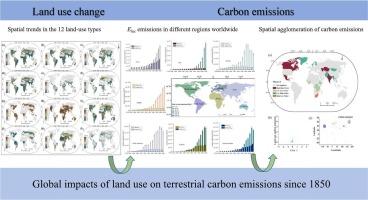1850年以来全球土地利用对陆地碳排放的影响。
IF 8
1区 环境科学与生态学
Q1 ENVIRONMENTAL SCIENCES
引用次数: 0
摘要
自工业革命以来,全球土地利用模式发生了重大变化,破坏了陆地碳排放。然而,干扰过程、变化趋势和分布模式尚不清楚。因此,本研究分析了1850年以来土地利用变化引起的陆地碳排放(Eluc)变化。结果表明,由于森林面积急剧减少(- 13.39%;84.26 × 105 km2),建设用地显著增加(+ 1360.4%;7.21 × 105 km2),耕地(+ 175.8%;130.88 × 105 km2)、草地(+ 162.6%;239.73 × 105 km2),全球Eluc从1850年的0.42 Pg C增加到2018年的11.05 Pg C,年均增加约3.42 Pg C -1,而21世纪以后的年均碳排放量达到9.65 Pg C -1。其中,直接Eluc增加了约0.80 Pg C,间接Eluc增加了2.62 Pg C。此外,从1850年到2018年,全球Eluc约为578.26 Pg C,其中北美、欧洲和亚洲是最大的区域来源。研究结果揭示了工业革命以来土地覆盖变化影响下全球陆地碳排放的变化趋势和分布格局,为区域和行业制定低碳减排政策和规划低碳土地利用模式提供了科学依据。本文章由计算机程序翻译,如有差异,请以英文原文为准。

Global impacts of land use on terrestrial carbon emissions since 1850
Since the Industrial Revolution, significant changes in global land-use patterns have occurred, which have disrupted terrestrial carbon emissions. However, the disturbance processes, change trends, and distribution patterns are not clear. Therefore, the changes in terrestrial carbon emissions (Eluc) caused by land-use change (LUC) since 1850 were analyzed in this study. The results showed that, owing to the sharp decrease in forestland (−13.39 %; 84.26 × 105 km2) and significant increases in built-up land (+1360.4 %; 7.21 × 105 km2), cropland (+175.8 %; 130.88 × 105 km2), and grassland (+162.6 %; 239.73 × 105 km2), the global Eluc increased from 0.42 Pg C in 1850 to 11.05 Pg C in 2018, with an average annual increase of approximately 3.42 Pg C yr−1, while the average annual carbon emissions after the 21st century reached 9.65 Pg C yr−1. Among them, direct Eluc increased by approximately 0.80 Pg C yr−1 and indirect Eluc increased by 2.62 Pg C yr−1. In addition, from 1850 to 2018, global Eluc was approximately 578.26 Pg C, with North America, Europe, and Asia being the largest regional sources. Our results highlight the changing trend and distribution pattern of global terrestrial carbon emissions under the influence of LUC since the Industrial Revolution and provide a scientific basis for regional and sectoral formulation of low-carbon emission-reduction policies and planning of low-carbon land-use patterns.
求助全文
通过发布文献求助,成功后即可免费获取论文全文。
去求助
来源期刊

Science of the Total Environment
环境科学-环境科学
CiteScore
17.60
自引率
10.20%
发文量
8726
审稿时长
2.4 months
期刊介绍:
The Science of the Total Environment is an international journal dedicated to scientific research on the environment and its interaction with humanity. It covers a wide range of disciplines and seeks to publish innovative, hypothesis-driven, and impactful research that explores the entire environment, including the atmosphere, lithosphere, hydrosphere, biosphere, and anthroposphere.
The journal's updated Aims & Scope emphasizes the importance of interdisciplinary environmental research with broad impact. Priority is given to studies that advance fundamental understanding and explore the interconnectedness of multiple environmental spheres. Field studies are preferred, while laboratory experiments must demonstrate significant methodological advancements or mechanistic insights with direct relevance to the environment.
 求助内容:
求助内容: 应助结果提醒方式:
应助结果提醒方式:


